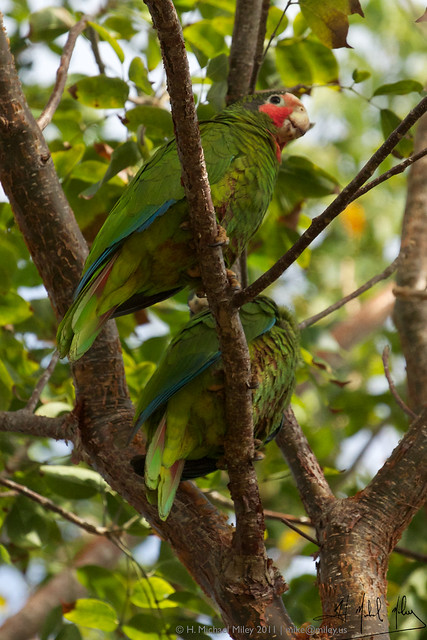 Cayman parrots. Image by H. Michael Miley
Cayman parrots. Image by H. Michael Miley
The Cayman parrot is facing a combination of threats which an international expert says could see the bird extinct within forty years if action is not taken to preserve the habitat the parrots need. Frank Rivera-Milán from the US Fish and Wildlife Service has been counting parrots in the Cayman Islands since Hurricane Ivan in 2004. During a presentation of his work here over the last eight years, Rivera-Milán issued a stark warning about the national birds and the threats they face which could in the face of another catastrophic event see them disappear.
Speaking at the Department of Environment on Wednesday, the bird expert noted the local parrots' recovery in the wake of both Hurricanes Ivan and then Paloma on the Brac, which demonstrated their relative resilience to face what nature throws at them, but the birds are struggling in the face of hunting and development.
He pointed to the population on Cayman Brac, which is a sub species and on its evolutionary way to becoming a species of its own, but is at particular risk because of the rapid development of roads and subdivisions on the Brac that are destroying its already very limited habitat.
“Cayman Brac is going down the drain as development is going too fast,” Rivera-Milán warned as he pointed to the significant amount of clearance of the birds’ habitat in the last few years. He warned that there are an estimated 465 parrots left on the island but only 66 breeding pairs. He explained the rest of the birds are known as 'floaters', which are not yet producing offspring.
While the breeding pairs have remained relatively constant over the last 20 years, the decline in floater numbers, which would replace any loss of breeders, is a significant problem for the future population if there was to be another major storm, he said.
“We are losing floaters and once that starts to happen extinction is not very far away. We have a very volatile situation with the parrot population,” he warned.
The situation on Cayman Brac is compounded by the significant lack of habitat which is suitable for parrots. The birds colonize only around 4,000 hectares of the island, so even when a small amount of the trees and scrub where the birds live, and more importantly nest, are removed their survival becomes ever more tenuous.
Warning that the birds could be gone in less than four decades, he said the government needed to intervene with management policies, such as preserving existing nesting areas and breeding hot-spots, introducing nesting boxes, as well as preserving and planting key food sources for the parrots and enforceable legislation to protect them from trapping and hunting.
“The more habitat that is lost, the more the recovery from the storms is hampered,” he said, adding that there seemed to be no need in many cases for the development of such large roads he saw on the bluff during this visit. “The Brac population is literally hanging on. We are really in trouble.”
He lamented that land was stripped bare in order to make subdivision without retaining any of the natural habitat and wondered why the roads accessing sub divisions were so wide. He described the new public highway to the Agricultural Pavilion as more fitting for a major US city than the tiny island. The impact on the habitat from roads is not just limited to the area cleared but, he explained, it also knocks into that on the edges of the road because of the pollution and wind shear.
Although the national bird is protected under the animals law, wildlife experts here say that legislation has no teeth and that is why the parrots, like the rest of Cayman’s indigenous wildlife, is in desperate need of the National Conservation Law. No one has ever been prosecuted for taking or killing a parrot and there are no statistics revealing how many birds are killed or trapped each year.
In Grand Cayman the bird is considered a pest by many farmers. The pressures of development are driving the birds from their natural habitat into the farms and suburban areas to find food as a result of the dwindling supplies in the wild. Although Rivera-Milán said the food supply on Grand Cayman appeared to be slightly better than on the Brac, the parrots there are still at risk.
The biologist's latest visit was focused on Cayman Brac and so his figures regarding Grand Cayman were, he said, best estimates but he pointed to around 4,000, which included 500 mating pairs. Rivera-Milán warned that these figures were still a major concern given the rate of development and the lack of any meaningful protection.
For the birds on both islands, Rivera-Milán said the habitat loss was dramatic and although it was still possible that both the Grand Cayman and the Cayman Brac parrots could make it, their survival depends very heavily on the will of government to make the right decisions regarding management and put the necessary policies in place to preserve the country’s national bird.